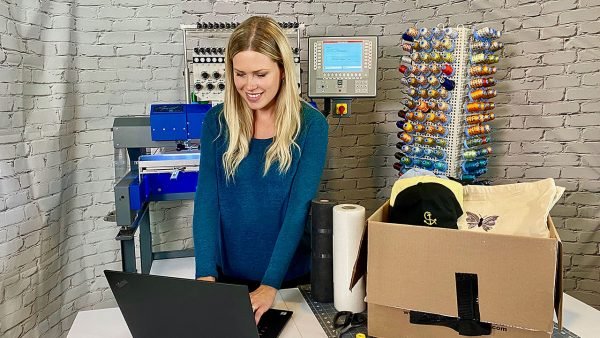
Embroidery has come a long way from hand-stitched tapestries to high-speed machine embroidery. But no matter how advanced the technology gets, one crucial step remains the same—turning artwork into stitches. That’s where digitizing comes in. If you’ve ever wondered how a logo, drawing, or even a photograph becomes an embroidered masterpiece, this guide will walk you through the process for digitizing files for embroidery in simple terms.
What Is Embroidery Digitizing?
Embroidery digitizing is the process of converting any image or design into a digital file that an embroidery machine can read. Unlike printing, where ink is applied to the surface, embroidery uses thread to create the design. This means the artwork must be translated into stitch types, directions, and sequences—a job that requires both technical skill and artistic understanding.
Think of it like giving GPS directions to your embroidery machine. The digitized file tells the needle where to go, how many stitches to make, and in what order. Without proper digitizing, even the most beautiful artwork can turn into a tangled mess of thread.
Why Digitizing Matters More Than You Think
You might assume that any image can be thrown into an embroidery machine and stitched out perfectly. Unfortunately, it’s not that simple. Here’s why digitizing makes all the difference:
- Stitch Quality: Bad digitizing leads to gaps, thread breaks, or stiff, puckered fabric.
- Detail Preservation: Small text and fine lines can disappear if not digitized correctly.
- Fabric Compatibility: A design that works on cotton might fail on stretchy or thick materials without adjustments.
- Efficiency: A well-digitized file stitches faster with fewer thread changes and less waste.
The Step-by-Step Digitizing Process
1. Start with the Right Artwork
Not all images digitize well. Simple, high-contrast designs with clean lines work best. Logos in vector format (like .AI or .EPS) are ideal because they can be scaled without losing quality. Photos or complex illustrations often need simplification before digitizing.
2. Choose Your Software
Digitizing requires specialized software. Some popular options include:
- Wilcom (industry standard, but expensive)
- Hatch Embroidery (more affordable, great for beginners)
- Embrilliance (user-friendly for smaller projects)
- Brother PE-Design (good for home embroiderers)
Auto-digitizing tools exist, but they rarely produce professional results. Manual digitizing—where a person maps out each stitch—is the way to go for quality work.
3. Set Up the Design Parameters
Before placing stitches, the digitizer defines:
- Size: How big the design will be (resizing later can cause problems).
- Fabric Type: Different materials need different stitch settings.
- Stitch Types: Common choices include satin stitches (for smooth edges), fill stitches (for solid areas), and running stitches (for fine details).
4. Map Out the Stitches
This is where the magic happens. The digitizer manually plots:
- Underlay Stitches: These stabilize the fabric and prevent distortion.
- Stitch Direction: Affects texture and durability (e.g., horizontal vs. vertical fills).
- Density: Too many stitches make the design stiff; too few leave gaps.
- Pull Compensation: Adjusts for fabric stretch so shapes don’t distort.
5. Test and Refine
Even pros don’t get it perfect on the first try. A test stitch-out reveals issues like:
- Thread tension problems
- Areas that need more or less density
- Misaligned elements
The digitizer tweaks the file until it stitches flawlessly.
Common Digitizing Mistakes (And How to Avoid Them)
1. Ignoring Fabric Type
A design digitized for denim will likely pucker on knit fabric. Always consider what you’re stitching on before digitizing.
2. Overcomplicating Small Details
Tiny text or intricate details may look great on screen but turn into a blurry mess when stitched. Simplify where necessary.
3. Skipping the Underlay
Without proper underlay, stitches can sink into the fabric or cause puckering. It’s like building a house without a foundation.
4. Using Too Many Stitches
Over-digitizing makes designs stiff and wastes thread. Sometimes, less is more.
5. Not Testing First
Never skip a test run. Stitching on scrap fabric saves time, materials, and frustration.
DIY vs. Professional Digitizing
If you’re just starting out, you might wonder if you can digitize yourself. Here’s the breakdown:
DIY Digitizing
- Pros: Saves money on small projects, gives creative control.
- Cons: Steep learning curve, time-consuming, results may be inconsistent.
Professional Digitizing
- Pros: High-quality files, optimized for your fabric/machine, faster turnaround.
- Cons: Costs more per design (though often worth it for important projects).
For occasional hobbyists, DIY might be fine. But for logos, business projects, or high-quality gifts, hiring a pro is usually the better choice.
Tips for Better Digitizing Results
Whether you’re doing it yourself or working with a digitizer, these tips help:
- Keep It Simple: Complex designs often need simplification for embroidery.
- Communicate Clearly: If outsourcing, specify fabric, size, and any special requirements.
- Use High-Quality Art: The better the original file, the better the digitized result.
- Start Small: Practice with simple shapes before tackling detailed artwork.
The Future of Embroidery Digitizing
Technology is making digitizing faster and more accessible. Some emerging trends include:
- AI-Assisted Digitizing: Software that suggests stitch types and optimizes paths automatically.
- 3D Puff Digitizing: Techniques for creating raised, textured embroidery.
- Cloud-Based Tools: Online digitizing services that eliminate the need for expensive software.
Still, human expertise remains essential for top-tier results.
Final Thoughts
Digitizing is the bridge between art and embroidery—a crucial step that determines whether your design stitches out beautifully or becomes a thread-filled disaster. While it takes practice to master, understanding the basics helps you make smarter choices, whether you’re digitizing yourself or hiring a professional.
The next time you see an embroidered logo or intricate design; you’ll appreciate the work that went into translating that image into stitches. And if you’re ready to try digitizing yourself, start simple, be patient, and don’t skip the test stitches. Happy embroidering!

